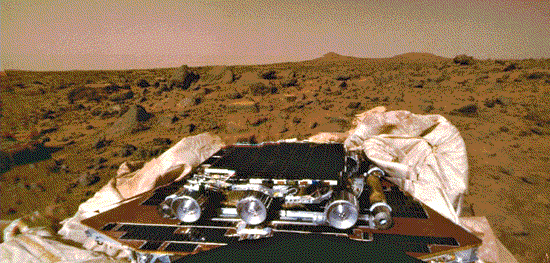| Even before the 1996 announcement that fossilized life may have been found on Mars (see Interlude 10-2), several robotic spacecraft destined to visit the Red Planet were already in the design and construction phase. Now the desire to confirm or deny the claims for life on Mars have given even greater urgency to those missions. Indeed, some of the spacecraft now being readied for launch after the year 2000 may be modified to increase their capability to search for signs of Martian life.
Typically, the relative positions of Mars and Earth in their respective orbits means that it is most favorable to launch a spacecraft from Earth every 2 years; it then takes 6 to 9 months for the craft to arrive at Mars. Mars Observer exploded mysteriously while entering Martian orbit in 1993. The replacement mission, Mars Global Surveyor, is currently surveying Mars from orbit. No part of this craft will land on the planet's surface. A Russian craft was launched in November 1996, to arrive at Mars in mid-1997. The previous time the Russians tried to rendezvous with the Red Planet, the twin spacecraft of the Soviet mission Phobos lost contact with Earth just as both craft were entering Mars's orbit. This time, unfortunately, fortune was no kinder. The rocket's final-stage booster failed to fire, and the probe ended up in the South Pacific Ocean. As described in the text, the most recent craft to land on Mars was Sojourner, part of the Mars Pathfinder mission. The accompanying image shows the Sojourner robot shortly after landing on July 4, 1997. The robot is still inside part of its parent ship; airbags and the parachute surround the vehicle on the surface. New data about Mars's rock and soil chemistry were among Sojourner's main findings. Surprisingly, many of the rocks sampled resembled those on Earth; they have more silicon than expected, suggesting that they came from volcanic activity on Mars, yet Mars shows little evidence of plate tectonics or other forms of geological activity. Weather conditions were also sampled over the course of several weeks, and a host of new images were obtained of this alien world. A significant controversy has developed regarding the Pathfinder mission, and especially its lander robot, Sojourner. The latter was not sterilized before leaving Earth. The only other spacecraft from Earth to land on Mars—two Viking robots in 1976—were sterilized in order |
not to introduce any kind of terrestrial bacteria into the Martian environment. Now that there are claims of life on Mars—even fossilized life—it might not be a good idea to run the risk of contaminating Mars with Earth life. This is one of those areas of debate that has become socio-scientific in nature.
The next spacecraft scheduled for touchdown on Mars, in late 1999, is Mars Surveyor Lander. The target area is Mars's south pole, a landing site thought to contain alternating layers of ice and dust. This robot lander is designed to drill into the layered terrain, permitting scientists to reconstruct some of the climatic history of Mars, in an attempt to understand conditions when the planet was warmer and wetter. It will also set up a completely automated meteorological station to study the changing Martian weather and will have a 2-m-long robotic arm to probe surface soil, ice, and rocks. Spacecraft builders are now investigating whether they may be able to add a device to this lander that will search for organic compounds typical of terrestrial life; even at the cold polar regions, such Martian life forms could conceivably These and other missions are seen as a prelude to one that will return samples of Martian matter to Earth robotically. Planned for the time frame 2005—2008, a landing craft on Mars will scoop up some dirt and rocks, leave that planet, then return the surface material at least to Earth orbit. Whether those pieces of Mars will then be brought to Earth's surface for detailed study is another part of the sterilization issue that needs to be thoroughly discussed. Will we contaminate the Mars rocks with terrestrial life by intentionally inviting them onto our home planet? Worse, will we be contaminating Earth with some sort of odd Martian bugs harmful to our own species? Our decisions could have important long-term consequences. All these above missions to Mars utilize automated robots only. No humans are involved in situ. Nor are there any missions planned at this time that will require astronauts to go along for the ride. Manned missions to Mars are currently considered too expensive and too risky, and it is unclear what humans could do in that harsh environment that robots could not. |
 |
|